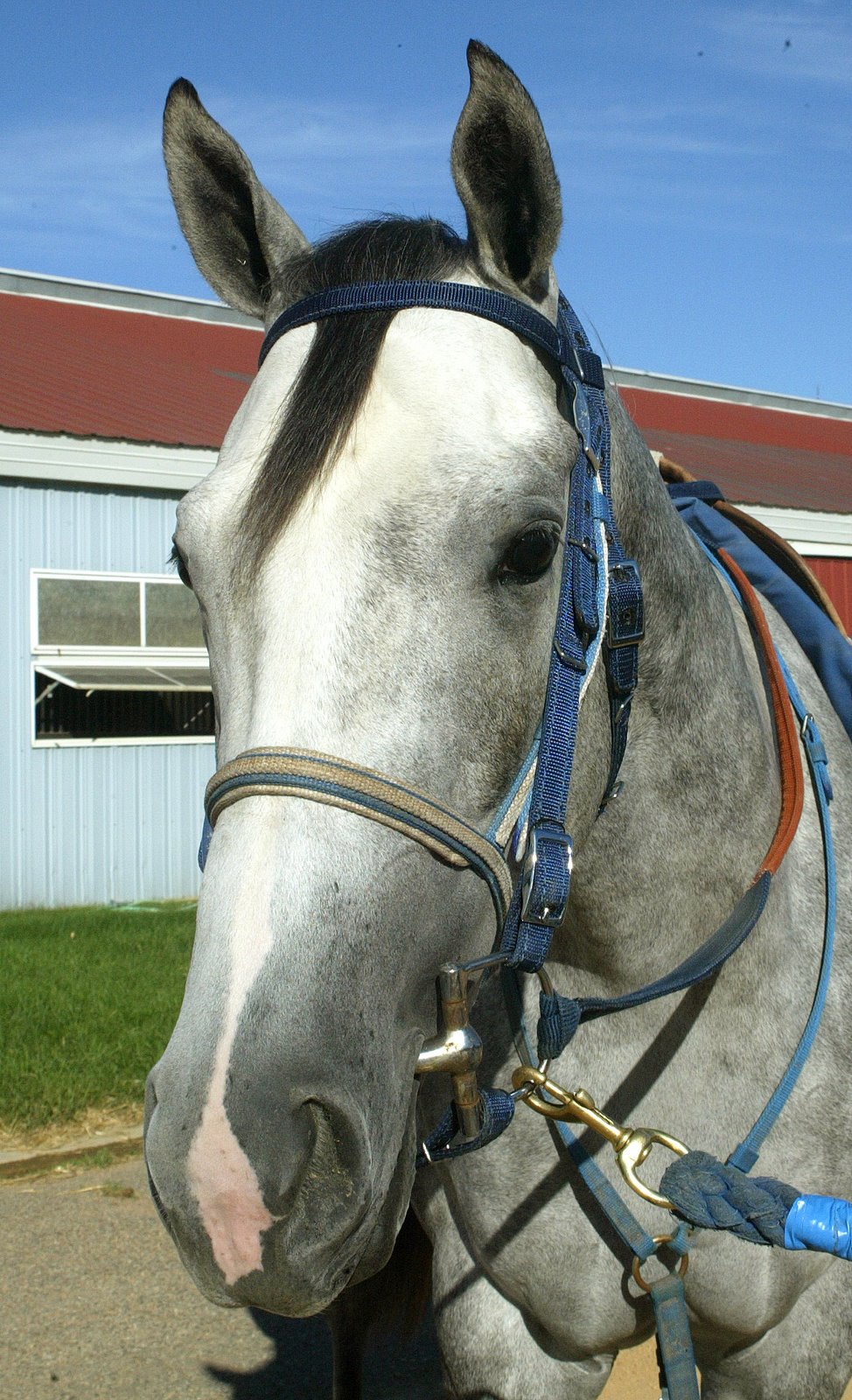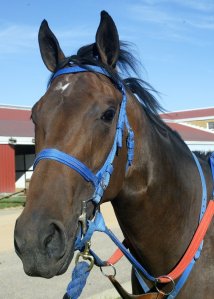The television series “Sister, Sister” in the 1990s featured twin siblings who were separated at birth and later reunited after running into one another while shopping. Fanciful television whimsy, right?
Well, take a look at Saturday’s racing card, at the ninth and 10th races, the Nos. three and five horses, respectively.
The first is a filly named Surf Runner. The second is a filly named Wave Rider.
Now, look at the breeding. Both horses are by First Down Dash. The dam in both cases is Runaway Wave.
And the point is?
Their ages. Both fillies are three years old.
Surf Runner and Wave Rider are not only sisters. They are twins. As unusual as it sounds, it happens in quarter horse racing more often than you’d think, and was made possible with a rule change by the American Quarter Horse Assn. that allows multiple registrations of horses from the same dam in a given year, the result of embryo transfers.
The transfer practice has become almost routine since passage of the rule in a 2003 re sponse to a suit against the AQHA by cutting horse groups.
sponse to a suit against the AQHA by cutting horse groups.
But at Canterbury Park? Twin sisters racing on the same card?
“This is a first,” said Quarter Horse Racing Secretary Josh Van Oort. “It’s happened in Oklahoma before, but not in Minnesota.”
What is clear about the sisters is that they are not identical twins. Not by any stretch of the imagination.
“They are tot ally opposite,” said trainer Lorraine Hoover. “Surf Runner, the gray one, is quiet and easy going. The bay one, Wave Rider, has a little attitude. She thinks she’s 10 feet tall and bullet proof on the way to the track. She’s on the muscle every day, snorting, dancing and prancing the whole way.”
ally opposite,” said trainer Lorraine Hoover. “Surf Runner, the gray one, is quiet and easy going. The bay one, Wave Rider, has a little attitude. She thinks she’s 10 feet tall and bullet proof on the way to the track. She’s on the muscle every day, snorting, dancing and prancing the whole way.”
Owner/breeder Dan Lucas has a ready explanation for the difference. “That mare throws those two types of horses,” he said. “Yes, they are totally different. One’s a little taller and lankier, the other blockier and more muscular. But both types can run.”
The twin fillies, born two days apart, are still trying to earn their racing stripes. Both have had setbacks of one kind or another in their racing careers, including knee surgeries.
Lucas, a retired emergency physician and resident of New Market, Md., bred the dam of the twins, mating the quarter horse Runaway Winner with the thoroughbred mare In the Curl.
“In the Curl raced until she was nine,” he said. “She was a wonderful race mare, earned about $750,000. She raced around here, at Monmouth, Pimlico and Laurel…I had my eye on her for a long time.”
The mare’s owners put her in for a claiming tag and Lucas took note. He contacted them afterward and bought the mare. “They were tired of racing her and had her in for $35,000,” he said. “I paid a little more than that. She was kind of small and blocky and they didn’t think she’d be a good thoroughbred broodmare, but she was a sprinter and I thought she’d be good breeding quarter horses.”
Runaway Wave was one of In the Curl’s first quarter horse babies and has produced three Grade I winners, two of them world champions. Wave Carver and Runaway Ocean both won the Champion of Champions at Los Alamitos. Now 13, Runaway Wave is among the top quarter horse broodmares by earnings _ all time.
The embryo transfer process involves flushing the embryo from the uterus of the mare a week or so after fertilization. The embryo is then implanted in a recipient mare. The procedure saves wear and tear of foaling on a valuable dam, increases the number of valuable foals and, in some cases, produces interesting results.
Horses will conceive twins a certain percentage of the time. Since typically there isn’t room in the uterus for two foals to develop, the mares generally won’t carry them full term and either abort or produce a stunted foal. When it’s discovered that a mare is carrying twins, one of the two is “pinched,” or eliminated, to increase the chances of the other’s survival. The mare is generally checked for twins two to three weeks after conception.
A mare is flushed for transfer at about seven days, before the embryo has attached to the uterus. When Runaway Wave was flushed, the result was twin embryos.
The AQHA does not keep statistics on twins born by the process, but does keep numbers on other aspects of embryo transfer, including horses conceived by the same dam and then foaled by another in the same year. The sire is not considered in such compilations. The dam of more than one embryo frequently is bred to different stallions.
As of Dec. 17, 2007, 4,426 sets of multiple foals were registered for that year. That number included 3,491 sets of two, 738 sets of three, 159 sets of four, 27 sets of five, eight sets of six, two sets of seven and even one set of nine. Working under the multiple foal rule, 10,038 foals were registered, the highest number for a year since the rule was implemented. A total of 3,821 dams of record were involved.
In the case of Canterbury’s twin sisters, the mating was done a bit differently than usual. Runaway Wave is stabled at Royal Vista Equine in Fort Collins, Colo., but was shipped to the stallion’s site, at Vessels Stallion Station near Bonsalls, Calif. Normally, quarter horse breeding is done by shipping the stallion’s semen, which Lucas would have preferred for Runaway Wave. “I don’t like shipping her around, but for some reason they weren’t able to ship the semen in the case of First Down Dash,” he said. “The mare had to be there.”
Royal Vista Equine is one of the locations in the country where embryos are implanted. Once Runaway Wave conceived and was flushed, the twin embryos were shipped to the Colorado site.
The twin sisters have raced on the same card previously. As two-year-olds, they were in separate heats of trials at Los Alamitos. They did not qualify that time. Hoover and Lucas are hoping for a different result this time.
“Both horses are picked last in their heats,” said Hoover. “Maybe it’s good to be underestimated. It certainly takes the pressure off.”
The twin girls have other family in the Hoover barn here at Canterbury, a full-brother named Trisk, a four-year-old who is being stall rested and is not likely to make a local appearance during the meet. The sisters, separated after conception and later rejoined at the racetrack, get their chance on Saturday. Proving once again that real life often produces tales more compelling and credible than television does.
HBPA MILE DRAWS 12
A full field of fillies and mares is entered for the $50,000 HBPA mile on the turf, feature event of today’s race card.
Eight of the 12 entries are Kentucky-bred fillies or mares, three are Florida-breds and the other is Irish-bred. The favorite is Inhonorofjohnnie, a 4-1 choice trained by Owen McQuade and ridden by Jesse Garcia.
Second choice at 5-1 is Lemonlime, a Kentucky-bred 4-year-old filly trained by Anthony Granitz and ridden by Willie Martinez. Lemonlime won the Northbound Pride Stakes here on the turf last summer.
The third choice, at 6-1 in the morning line odds, is Couple Whiles, trained by Bernell Rhone and ridden by Dean Butler for local owners Will Carlson and Jerry Pint.
IT’S A GIRL FOR THE VAN OORTS
Quarter Horse Racing Secretary Josh Van Oort was missing from the racing office this week. He wanted to be on hand for his daughter’s birth in Claremore, Okla. He became a father for the first time on Tuesday when his wife, Brooke, gave birth to a girl.
The Van Oorts will name their daughter, Grace Hope, to honor grandmothers on both sides of the family.
Hope is the name of Brooke’s paternal grandmother. Grace is the name of Josh’s maternal grandmother.
Mother and daughter were doing well. Josh said the three of them intend to head to Shakopee Saturday night or Sunday morning. The baby’s baptism will possibly take place here some time later.
The Dean Kutz Memorial Chapel would seem like an appropriate spot _ if, in fact, it opens as planned in July.